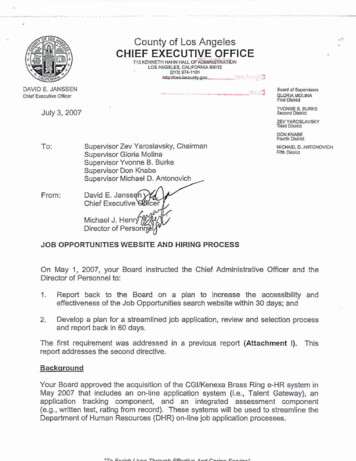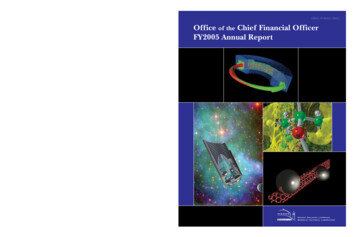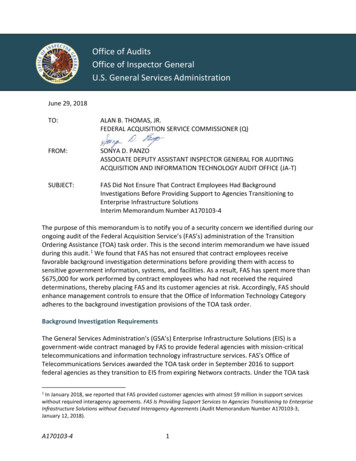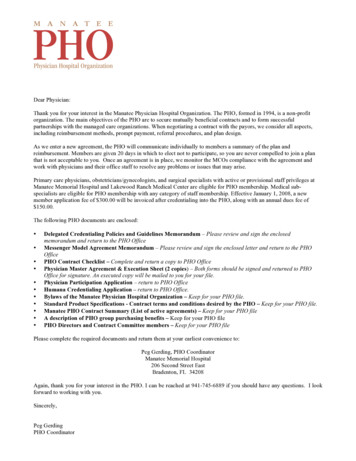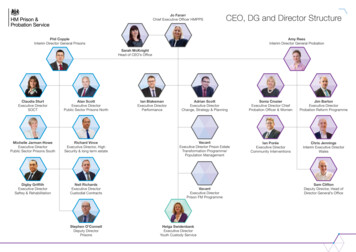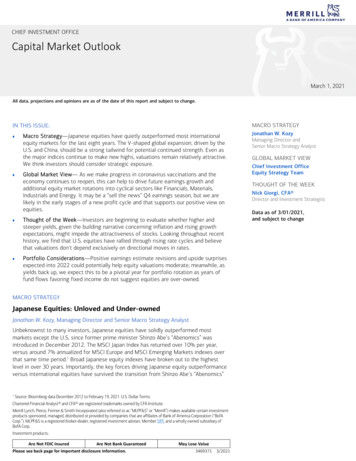
Transcription
CHIEF INVESTMENT OFFICECapital Market OutlookMarch 1, 2021All data, projections and opinions are as of the date of this report and subject to change.IN THIS ISSUE:MACRO STRATEGY Jonathan W. KozyManaging Director andSenior Macro Strategy Analyst Macro Strategy—Japanese equities have quietly outperformed most internationalequity markets for the last eight years. The V-shaped global expansion, driven by theU.S. and China, should be a strong tailwind for potential continued strength. Even asthe major indices continue to make new highs, valuations remain relatively attractive.We think investors should consider strategic exposure.Global Market View— As we make progress in coronavirus vaccinations and theeconomy continues to reopen, this can help to drive future earnings growth andadditional equity market rotations into cyclical sectors like Financials, Materials,Industrials and Energy. It may be a “sell the news” Q4 earnings season, but we arelikely in the early stages of a new profit cycle and that supports our positive view onequities. Thought of the Week—Investors are beginning to evaluate whether higher andsteeper yields, given the building narrative concerning inflation and rising growthexpectations, might impede the attractiveness of stocks. Looking throughout recenthistory, we find that U.S. equities have rallied through rising rate cycles and believethat valuations don’t depend exclusively on directional moves in rates. Portfolio Considerations—Positive earnings estimate revisions and upside surprisesexpected into 2022 could potentially help equity valuations moderate; meanwhile, asyields back up, we expect this to be a pivotal year for portfolio rotation as years offund flows favoring fixed income do not suggest equities are over-owned.MACRO STRATEGYJapanese Equities: Unloved and Under-ownedJonathan W. Kozy, Managing Director and Senior Macro Strategy AnalystUnbeknownst to many investors, Japanese equities have solidly outperformed mostmarkets except the U.S. since former prime minister Shinzo Abe’s “Abenomics” wasintroduced in December 2012. The MSCI Japan Index has returned over 10% per year,versus around 7% annualized for MSCI Europe and MSCI Emerging Markets indexes overthat same time period.1 Broad Japanese equity indexes have broken out to the highestlevel in over 30 years. Importantly, the key forces driving Japanese equity outperformanceversus international equities have survived the transition from Shinzo Abe’s “Abenomics”1Source: Bloomberg data December 2012 to February 19, 2021. U.S. Dollar Terms.Chartered Financial Analyst and CFA are registered trademarks owned by CFA Institute.Merrill Lynch, Pierce, Fenner & Smith Incorporated (also referred to as “MLPF&S” or “Merrill”) makes available certain investmentproducts sponsored, managed, distributed or provided by companies that are affiliates of Bank of America Corporation (“BofACorp.”). MLPF&S is a registered broker-dealer, registered investment adviser, Member SIPC and a wholly owned subsidiary ofBofA Corp.Investment products:Are Not FDIC InsuredAre Not Bank GuaranteedPlease see back page for important disclosure information.May Lose Value3469371 3/2021GLOBAL MARKET VIEWChief Investment OfficeEquity Strategy TeamTHOUGHT OF THE WEEKNick Giorgi, CFA Director and Investment StrategistData as of 3/01/2021,and subject to change
to Yoshihide Suga’s “Suganomics,” and valuations are still reasonable. Investors who havemissed the ride should consider strategic asset allocation exposure.The V-shaped global expansion, driven by the U.S. and China, should be a strong tailwindfor potential continued strength in Japanese equities. Profits growth in Japan is tightly tiedto global growth with more than half of revenues of Japanese companies derived fromoutside Japan, according to Gavekal Research. While the level of real gross domesticproduct (GDP) in Japan remains below the pre-coronavirus high, both profits and realexports have already made new highs, reflecting the strength of the global expansion andthe ability of Japanese companies to leverage it. Importantly, global leading indicatorscontinue to point toward strong global growth. In the U.S., for example, the LeadingEconomic Index (LEI) registered an above-consensus 0.5% gain in January and points tostrong growth through year-end. The yield curve is a key component and is currentlysteepening, a positive signal that foreign demand for Japanese goods has the potential toremain robust.Like in the U.S., aggressive stimulus is a near-term tailwind and is more aggressive than inEurope. Money supply (M2) is up 9.4% year-over-year (YoY) and fiscal stimulus is helpingto keep corporate bankruptcies near record lows.2 The Bank of Japan remains active inpurchasing equity exchange-traded funds (ETFs) in support of its reflation goal and hasthe 10-year yield pinned near zero, thus limiting concerns (seen in the U.S., for example)that rising long rates may stifle growth. Fiscal stimulus has been massive and comparableto the U.S., with outlays totaling around 20% of GDP.Given the international exposure, currency plays an important role in the outlook foreconomic growth and equities in Japan, and the yen remains cheap relative to longer-termpurchasing power parity metrics. The yen averaged 100 during last decade’s expansionbut risk-on sentiment has weakened it to an even more competitive 105 more recently. Ifthe track of U.S. yields continues to move higher as we suspect, the yen could experiencefurther downward pressure and continue to support the already competitive export-drivenequity market. It is worth noting that Japanese equities performed relatively well duringthe “taper tantrum” of 2013.Japanese companies are currently flush with cash and have very strong balance sheets.Businesses have nearly 3 trillion dollars in cash, according to third-quarter nationalaccounts data (the latest available). Corporate cash is 60% of Japan’s nominal GDP, leavingplenty of room for the potential to raise dividends, repurchase shares, invest, or engage inmergers and acquisitions.Exhibit 1: Japanese Equities Relatively Attractive Versus U.S. Equities.3.5 %MSCI U.S. to MSCI Japan price to 2016201720182019202020211.0Sources: Bloomberg; Morgan Stanley Capital International. Data as of February 22, 2021. Past performance is no guarantee of futureresults.2Tokyo Chamber of Commerce and Industry as of February 22, 20212 of 8March 1, 2021 – Capital Market Outlook
Valuations are currently attractive on a relative basis and not overly expensive on anabsolute basis. The relative price-to-book of U.S. equities versus Japanese equities is nearan all-time high using MSCI All Country World Index (ACWI) equity index data (Exhibit 1).On an absolute basis, normalized price-to-economy wide operating profits are slightlyabove zero (the historical average), suggesting valuations are not extreme.3 A comparablemeasure in the U.S. is over 2 standard deviations above normal. And Japanese equitieshave a dividend yield around 2%, compared to near-zero on 10-year government bonds.A greater focus on return on equity (ROE) and other governance reforms (like independent,diverse boards) were among the more important accomplishments of the Abeadministration and are likely to continue under Prime Minister Suga. Reforms andderegulation are making Japanese equities currently more attractive to activist investors,while the focus on ROE could be a catalyst for multiple expansion in the years ahead.Geopolitically, Japan has managed to reinforce its commitment to free trade and its positionas a beneficiary of global growth, even as relations sour between the U.S. and China. As awell-developed example, Japan signed on to the November 2020 Regional ComprehensiveEconomic Partnership (RCEP), strengthening its trade relations with China, whilesimultaneously maintaining security ties with the U.S. in the region through regional defenseagreements and alliances. Japan was one of the biggest beneficiaries of RCEP, as it will seetariffs reduced on a significant percentage of the products it exports to China. It has alsosigned bilateral trade agreements with the U.S. and Australia.Foreign investors seem not impressed, as gauged by a number of sentiment metrics, leavinglots of room for flows to pick up. Net inflows to Japanese ETFs since December 2012 arenear zero, and the latest BofA Global Research Fund Manager Survey shows only a net 8% ofinvestors are overweight Japanese equities. Long-term pessimism surrounding Japaneseequities remains well entrenched and is centered around weak demographics and lowerpotential growth, a story for Europe also. But this misses an important feature of Japan’seconomy by ignoring productivity, which is relatively better than Europe’s. For example.Organisation for Economic Co-operation and Development (OECD) data from 2013 through2018 (the most recent data available) show multifactor productivity outperforming Franceand Italy and matching that of Germany, and labor productivity per hour worked well abovethe major European countries over that time period.4 Japanese companies are also wellpositioned to benefit from key themes like digitalization, consumer robotics and the Internetof Things.One risk to our positive outlook for Japanese equities is unexpected economic weakness inthe U.S. or China that derails the solid global demand backdrop. Second, the surge in theglobal business expenditure cycle (CAPEX) that was related to the pandemic (money typicallyspent on services was being spent on goods) was an important tailwind for Japaneseequities that could also fade as the pandemic recedes. These could lead to near-termunderperformance. If inflation picks up, there is headline risk from the Bank of Japan pullingup the anchor on the 10-year yield, but this seems unlikely in the next few years. Importantly,these do not derail the more fundamental reasons Japanese equities have outperformedEurope and emerging markets over the last eight years.3Applied Global Macro Research January 2021.4OECD, Haver Analytics February 2021.3 of 8March 1, 2021 – Capital Market Outlook
GLOBAL MARKET VIEWSell the News: Fourth-Quarter Earnings ReviewChief Investment Office, Equity Strategy TeamAs the current earnings season winds down, the majority of S&P 500 companies reportedbetter-than-expected fourth-quarter earnings results compared to consensus expectations,with 78% of companies beating expectations. Fourth-quarter 2020 earnings also turnedpositive, growing 5% for companies that reported Q4 results so far, compared toconsensus estimates prior to earnings season of -9% earnings growth. However, the initialreaction for many stocks was to “sell the news” of improved earnings results, even for thecompanies that beat on both sales and earnings. Investors may ask why stocksunderperformed after reporting better-than-expected earnings. It is important toremember the equity market is considered forward looking and discounts future earningsand cash flows ahead of actual results. The equity market as measured by the S&P 500index discounted the improving economic and earnings environment with gains of over20% and 11%, respectively, for the second half and fourth quarter of 2020. Arguably, theearnings improvements for Q4 were already discounted or baked into stock prices prior tothis earnings season, and the market is currently consolidating the strong rally from lastspring, in our opinion.The muted reaction to Q4 earnings is not a signal that the earnings recovery is over. Tothe contrary, a new profit cycle recently started and can continue over the course of 2021,in our view. The Street may still be underestimating the tailwinds from the recordstimulus, improving coronavirus vaccination numbers, rebound in economic data, andrecovering sentiment from both consumers and corporations on the gradual reopening ofthe economy. Surprising many market participants, the S&P 500 experienced sequentialearnings growth in Q4 for the first time since Q4 2019. In the coming quarters, earningsexpectations and YoY comparisons could provide an attractive setup for additional positiveearnings revisions and for earnings to potentially beat expectations given that earningsestimates were cut too drastically last year.Furthermore, initial S&P 500 consensus earnings estimates were not only negative forQ4, but also below the weak and negative Q3’20 results. This was too bearish, andconsensus earnings estimates were revised higher over the course of the fourth quarterand into 2021 as the Street and analysts realized estimates and expectations were toolow (Exhibit 2). Despite earnings revision ratios (ERR) moving higher over the course of Q4,earnings are still coming in above expectations, with 79% of companies reporting upsidesurprises to earnings compared to a five-year average of 74% above expectations. Wecould see earnings revisions moderate in the short term with some market consolidationand as analysts finish updating estimates as earnings season ends. We would not view thisas negative, as earnings estimates catch up to the rally in stock prices last year.Exhibit 2: Trends In Earnings Expectations By Region.Global Regions—3-month Earnings Revision RatioGlobal EmergingMarkets** Estimate. Source: BofA Global Research, MSCI, IBES. Data as of February 24, 2021. Performance would differ if a different time periodwas displayed. Short term performance shown to illustrate more recent trend. Past performance is no guarantee of future results.4 of 8March 1, 2021 – Capital Market Outlook
In addition, as earnings improve off the 2020 low base, we could see elevated valuationmultiples contract as the denominator in the price-to-earnings (P/E) ratio increases. In2020, equity market gains were driven by P/E multiple expansion, but now we are in thepart of the profit cycle where earnings growth would be the key driver of future equitymarket gains.Cyclical and Defensive StocksEarnings growth surprises have come from the Financials, Technology, Healthcare,Materials and parts of the Consumer sectors. Importantly, and part of the thesis forpotential upside to aggregate earnings from current levels, some cyclical industries arestill experiencing negative earnings growth. As the economy reopens and reflationcontinues, we expect to see potentially strong improvements in revenues for commodityrelated industries (Materials and Energy sectors), transportation, travel and leisure, andrestaurants. We saw the consumer adapting to the pandemic in 2020 and omnichannel (instore and online) retailers likely benefited from the acceleration in e-commerce sales.Across both Consumer Staples and Discretionary, a lack of price discounting or promotionscould be additive to operating leverage and profit margins. Data on consumer disposableincome, savings levels and stimulus checks remain supportive to the consumer outlook,even before considering the potential for pent-up demand in consumer activities andservices. Healthcare results were better-than-expected overall, but guidance wasunderwhelming and probably overly cautious amid uncertainties for coronavirusvaccination timing and new policy. Potential policy changes from the Biden administrationcould be a near-term overhang, especially for the managed care industry. Investor focuscontinues to be on life sciences, tools, medical tech devices and healthcare technology(digitalization).In general, Technology continued to benefit in Q4 from the digitalization of the economyand accelerating trends from the pandemic. Although supply chains and inventory issues inthe semiconductor industry could result in some inconsistent results near term, demandfor technology products remains solid. Technology was an equity market leader overrecent years, but some recent profit taking on better-than-expected results could besignaling a rotation to the more cyclical areas of the market, and more cyclical areas ofTechnology like semiconductors and semiconductor capital equipment. Digital paymentfundamentals remain strong, and the longer-term outlook for this thematic trend remainspositive. Financials reported some of the largest Q4 earnings beats amid higher creditcard volumes, increased capital market activity, and banks releasing some excess capitalreserves, which is a trend that should continue over 2021 and be a tailwind to bankearnings.Energy earnings are still negative YoY with realized energy prices for Q4 2020 still lowercompared to Q4 2019 oil price levels, but oil and natural gas prices are currently movinghigher and with significant operating leverage built into energy companies over recentyears, there is considerable room for energy earnings to move higher in 2021. Similarly,Industrial stocks could see earnings improvements on the back of the global economyreopening and some Industrials with commodity exposure reported strong Q4 results.Materials experienced strong growth in Q4 earnings as volumes started to improve,consumer product demand remains firm, and rebounds in the automotive, durable goodsand construction markets. Inventories are at low levels and are helping to drive improvingpricing trends and margin improvement. There are some early signs of cost inflation,including logistic, energy and raw material cost inflation, but these cost increases are notlarge enough right now and not a large enough weight of aggregate S&P 500 earnings toderail the earnings improvement story.The cyclical areas of the equity market could deliver operating leverage as the economycontinues to open as a result of lower cost structures and more efficient operationalimprovements made over the last few years. Large portions of these improvements arelikely driven by technology and automation. Pricing power will be watched closely to seehow it offsets any future cost inflation and its effect to earnings. In addition, the reflationpressures position cyclical earnings for recovery, while defensive and bond proxy stocksmay see stable to low growth in earnings. With operating leverage at some of the highestlevels in the last decade, future top line sales growth will likely be a catalyst to help drive5 of 8March 1, 2021 – Capital Market Outlook
higher earnings in coming quarters. We are not in the part of the cycle where defensiveequities outperform, and equity portfolios could have a good balance of secular growthand high quality cyclical equities. As we make progress in coronavirus vaccinations and theeconomy continues to reopen, this can help to drive future earnings growth and additionalequity market rotations into cyclical sectors like Financials, Materials, Industrials andEnergy. It may be a “sell the news” Q4 earnings season, but we are in the early stages of anew profit cycle and that supports our positive view on equities.THOUGHT OF THE WEEKAll Rise? Equities Have Gained Through Recent Episodes Of RisingRatesNick Giorgi, CFA , Director and Investment StrategistThe S&P 500 hesitated last week, while Treasury yields have crept higher. The buildingnarrative concerning inflation and rising growth expectations has contributed to asteepening of the curve, and investors are evaluating whether this might impede therelative attractiveness of stocks. In recent history, we find that U.S. equities haveconsistently rallied through rising rate cycles, with small-cap equities potentiallybenefiting, in particular. Moreover, research suggests that valuation does not alwaysdepend exclusively on directional moves in rates.Over the past 25 years, there have been nine cycles where 10-year U.S. Treasury yieldsincreased by 100 basis points (bps) or more. In each and every instance the move higher inyields coincided with positive total returns for both the S&P 500 and Russell 2000, withaverages of 17.6% and 26%, respectively (Exhibit 3). These figures are even moreimpressive considering that they took place during relatively sh
Mar 01, 2021 · All data, projections and opinions are as of the date of this report and subject to change. . Merrill Lynch, Pierce, Fenner & Smith Incorporated (also referred to as “MLPF&S” or “Merrill”) makes available certain investment . plenty of room for the potential to
